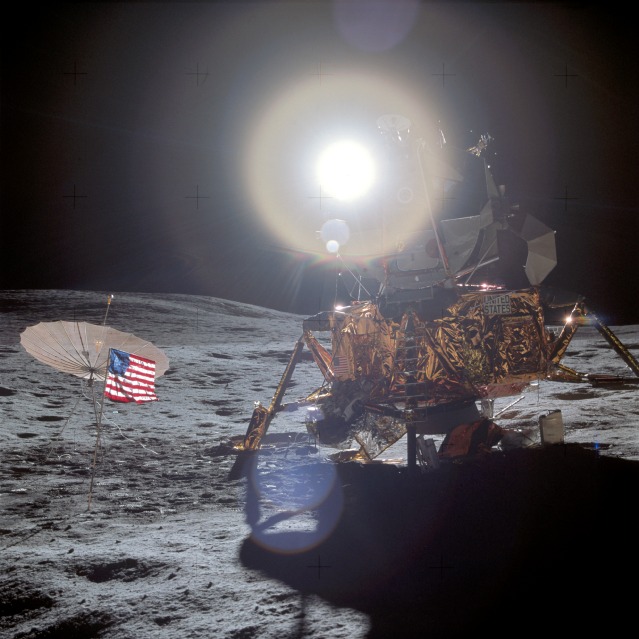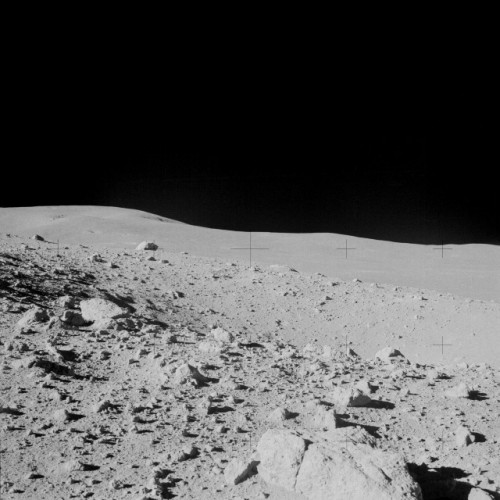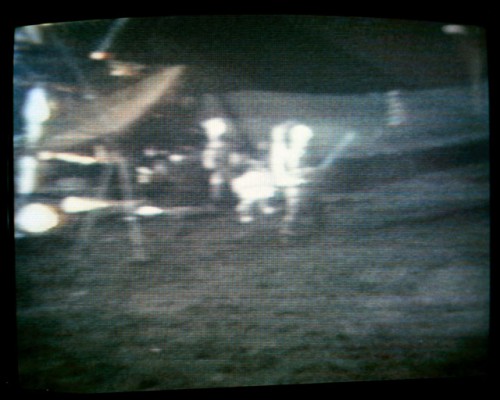
For those of us born within the last four decades, the notion of looking up at the Moon and knowing that fellow human beings are living and working there has been as alien as the dusty surface itself. But for a short handful of years, between July 1969 and December 1972, six teams of astronauts—12 humans in total—landed on our closest celestial neighbor and performed our species’ first in-situ reconnaissance of another world. Forty-five years ago, last week, Apollo 14 Moonwalkers Al Shepard and Ed Mitchell completed an arduous two days of exploration at the Fra Mauro foothills, a place originally destined to be the landing site for the ill-fated Apollo 13, whilst their crewmate Stu Roosa performed his own program of lunar science from orbit.
On 5 February 1971, Shepard and Mitchell wrapped up the first of two planned “Moonwalks.” Four hours and 47 minutes after the last wisps of air had been vented from their Lunar Module (LM), nicknamed “Antares,” the two men lugged the last of their rock and soil samples inside the lander and repressurized the cabin. Their sleep that night was far from comfortable, particularly since Shepard had set the lander down with one footpad in a shallow crater, meaning their whole point of reference was noticeably tilted to one side. Within the darkened cabin, shades having been put up against the triangular windows and the small rendezvous window in the roof, the sensation was one of silent, eerie stillness in the desolate landscape of Fra Mauro. With his burgeoning interest in psychic phenomena, it is not surprising that Mitchell acutely sensed the spiritual weight of being the only two living creatures on this otherwise lifeless world. Every so often, he rose from his hammock to lift the shades and gaze outside at the desolate, alien scene.
On more than one occasion, both men were also awakened from their light slumbers by the mild groaning of Antares’ systems, the rustling of its paper-thin walls, and the gentle hiss of its life-support machinery; Shepard even wondered if the lander was tipping over. One conversation between them is particularly comical:

“Ed? Did you hear that?” Shepard whispered.
“Hell, yes, I heard that.”
“What the hell was that?”
“I don’t know.”
A few seconds passed. Then:
“Ed?”
“What?”
“Why the hell are we whispering?”
By 3:30 a.m. EST on 6 February, they were back outside, loading the golfing-caddy-like Mobile Equipment Transporter (MET) with their tools to begin the traverse to Cone Crater, from where it was expected they would photograph the interior and gather samples from the rim. Perhaps, lunar geologists hoped, those samples would reveal clues about the Imbrium impact.
The hike across the hummocky terrain proved tougher than anticipated. With Shepard pulling the MET and Mitchell studying the map, it became clear after an hour that the rim of Cone Crater was farther away than expected. “Checkpoint” craters which seemed obvious on the map were now hard to find, and the whole region seemed like an endless “sea” of sand dunes, with yawning depressions, perhaps 16 feet (5 meters) deep, everywhere. “That next crater,” they would think, “ought to be 330 feet (100 meters) away”, but invariably, it was nowhere to be found. Sometimes, Shepard later wrote, they “would appear to walk along flat ground when their legs disappeared and reappeared, like small ships on a heaving sea. In reality, they strode through great shallows in the plains of Fra Mauro.”
With difficulty, they found their first sampling stop, then their second, and managed to linger for just a few minutes to grab some rock and soil specimens, take a few photographs, and acquire readings with their portable magnetometer. Then it was time to tackle the ridge itself. Here, Shepard and Mitchell found surer, firmer footing, but as they threaded their way upward the presence of rocks everywhere slowed their progress considerably. Whenever the MET hit a rock it jumped up off the ground, and the astronauts were concerned that it might topple over. At length, Shepard grabbed it, and the two men carried it.
Watching from Mission Control, in addition to Capcom Fred Haise—who had trained to perform just this traverse as the lunar module pilot of Apollo 13—were the backup landing team of Gene Cernan and Joe Engle. Before launch, they had bet Shepard and Mitchell a case of scotch that they would be unable to make it up the ridge whilst dragging the bulky MET behind them.
“There are two guys sitting next to me who kinda figured you’d end up carrying it up,” Haise observed.

Yet the climb was difficult and their bulky space suits fought their every move. Every so often, Shepard and Mitchell paused for a breather and took time to look back down the slopes toward Antares; clearly visible in the slanting lunar sunlight were the tracks from the MET’s two rubber wheels, interspersed with their own bootprints. It was becoming increasingly clear, though, that they were still far from their objective. The lack of reliable landmarks and the unreal clarity of the scene made it impossible to determine exactly where they were; at one stage, convinced that they were approaching the rim of Cone Crater, both men were disappointed that they had only crested an inflection in the flank of the ridge, and that their climb was not yet over. After the mission, they would liken the optically illusive effect to looking at a mountain in clear air conditions on Earth; although a peak might seem to be quite close, in reality it was some distance away.
Many of the geologists listening to Shepard and Mitchell’s efforts were not surprised that they were having trouble navigating their way around. It was one thing to recognize a lunar feature from orbit, but something quite different to view it on the surface. The climb was steadily taking it out of the astronauts—at one point, Shepard’s heart rate reached 150 beats per minute—and the flight surgeon asked for a pause, then queried the geologists: How important was it to reach the rim of Cone Crater? From the perspective of better understanding the Moon’s early history, it was important, but not vital. It was believed that rocks near the crater’s edge would yield some of the deepest and oldest material. In effect, the crater was a drill hole that would enable them to sample material that was otherwise deeply buried. By finding such material, Shepard and Mitchell would be travelling back in time, to only a few hundred million years after the Moon’s formation.
The men’s thoughts seemed to be diverging at this stage, more than an hour into the traverse, with Shepard keen to gather samples where they were at that time and then turn back, and Mitchell eager to press on. Mitchell felt that the mission would be a failure if they did not reach the rim of Cone Crater, if only to have the awe-inspiring opportunity to look into its 1,000-foot (300-meter) bowl. On the other hand, geologists doubted that they would see anything of significance, because photographs from orbit showed no signs of exposed layering or other significant structural features. The message to call a halt was passed to Fred Haise. They should, he told Shepard and Mitchell, consider where they were to be the edge of the crater.
Mitchell was bitterly disappointed. “Think you’re finks!” he said. However, Haise gave them some good news: If they thought that they could reach the rim soon, they could press on a little further. Shepard decided to give it a shot. On and on they climbed, again stopping for a breather a few minutes past 5 a.m. EST, gazing in bewilderment at the enormous boulders all around them, ejected by the impact which formed Cone Crater. From Mission Control, Deke Slayton offered to cover Cernan and Engle’s bet if they left the MET and carried on without it. Much as Shepard and Mitchell appreciated the thought, neither of them wanted to leave their stash of geology tools behind. As far as they knew, they might be almost at the rim.

By now, both men were drenched in perspiration, gulping intakes of oxygen, and the internal temperatures of their suits were rising dramatically. The search was proving fruitless. At length, Shepard radioed: “We’re right in the middle of the boulder field on the west rim. We haven’t quite reached the rim yet.” Mitchell took this as an admission that the search was over. In fact, both astronauts believed themselves to be at different places: Shepard thought they were close to the crater’s western edge, but Mitchell was sure that they were somewhere to the south. If they headed north, Mitchell argued, they would reach the rim. They continued walking and, studying his map, Mitchell was convinced that they should be able to see a prominent boulder. They could not, and by this point, nearly two hours since leaving Antares, they were running out of time. Haise told them to stop searching for the crater and begin taking samples.
The return downhill toward the lander, though disappointing, was exhilarating and both men could take full advantage of one-sixth terrestrial gravity, bounding in wide, slow-motion jumps. Back at Antares, they loaded the rock and soil boxes—totaling 99 pounds (45 kg) of lunar material—inside and took a few moments to catch a last glimpse of Fra Mauro. Before returning inside, Shepard took one final chance to have a spot of fun on the Moon, taking a golf ball from his pocket and dropping it onto the surface. (He had gotten the idea when he showed comedian Bob Hope around Mission Control a few months earlier.) “Houston,” he radioed, “I have in my hand the handle for the contingency sample return and just so happens I have a genuine six-iron on the bottom of it. In my left hand, I have a little white pellet that’s familiar to millions of Americans. I drop it down.”
Unfortunately, with the stiffness of the suit, Shepard could only operate one-handed and his first swipe missed totally. Mitchell told him that he got more dirt than ball. A second swipe shanked the ball and sent it into a pathetic dribble. He dropped a second ball into the dust. This time, he was more successful, and the ball sailed in impossibly slow motion into the distance. “Miles and miles!” he cried. In truth, it flew a few hundred feet. Before launch, he had told Deke Slayton, who made him promise only to do it if everything else was going well, but Mitchell had not been made privy to the caper.
In fact, Shepard had sneaked out of crew quarters on a number of occasions, donned his suit, and practiced his swing. The last thing he wanted, with a worldwide audience tuning in, was to fall flat on his face.
By the time Antares’ cabin was repressurized, the second Moonwalk had lasted four hours and 35 minutes, bringing the Apollo 14 experience to over nine hours. Subsequent analysis of Shepard and Mitchell’s photographs, correlated with images from orbit, would show that they came within 66 feet (20 meters) or so of the rim of Cone Crater. In fact, a large saddle-shaped rock they had sampled was on Mitchell’s map! A few steps farther north, and they would have seen the pit of Cone Crater open up before them! Less than eight hours later, Antares’ ascent stage was barreling its way back into orbit in order to rejoin Kitty Hawk.
During his time alone aboard the Command and Service Module (CSM) Kitty Hawk, their crewmate Stu Roosa had undertaken much of the detailed observation work originally planned for Apollo 13. Key to this effort was the huge Hycon Lunar Topographic Camera, which he had installed in the command module’s hatch window. The device, with its motorized film transport, exposure controls, and timer, was capable of resolving surface features just a couple of metres across, although it had proven somewhat sluggish to get up and running. It took 140 frames, then began making peculiar clanking noises. Roosa unplugged its cables and reconnected them, to no avail, and despite troubleshooting advice from Houston, he ran out of time and had to press on with other work.
Docking at 3:35 p.m. EST was followed by the sound of Shepard knocking from his side of the hatch. “Who’s there?” asked Roosa, before admitting them. A perfect SPS burn later that day set them on course for home. The return journey was a calm one, although a few experiments were performed in electrophoresis, liquid transfer between containers, heat transfer, and the casting of materials from a molten state. Kitty Hawk splashed down in the South Pacific, within view of the aircraft carrier U.S.S. New Orleans at 4:05 p.m. EST on 9 February 1971.
With the exception of narrowly missing the rim of Cone Crater and the close shaves during the journey to the Moon, Apollo 14 had proven hugely successful. In the eyes of the space workforce, Shepard, Roosa, and Mitchell had saved the lunar program and recovered from the ordeal that had befallen Jim Lovell’s crew. Yet the public at large still seemed peculiarly disenchanted by the prospects of further Moon landings. Only three more expeditions remained on NASA’s books, although those were expected to be the grandest of all. All three would be designated as “J-series” lunar voyages and would spend three days on the surface, feature three Moonwalks as long as seven hours apiece and conduct advanced scientific research from orbit.
This is part of a series of history articles, which will appear each weekend, barring any major news stories. Next week’s article will focus on the 15th anniversary of STS-98, a shuttle mission which delivered the U.S. Laboratory Destiny—the “heart” of the International Space Station (ISS)—and installed it onto the growing orbital outpost.
Be sure to “Like” AmericaSpace on Facebook and follow us on Twitter: @AmericaSpace




Each written word, each photograph from the Apollo missions are reminders that we as a species have accomplished something truly remarkable that will live forever in human history. And we are fortunate that the brilliant minds and brave individuals combined their efforts with wondrous results shared by all humanity.
Each written word, each photograph from the Apollo missions are reminders of the monumental wrong turn that was made when we retreated to LEO. And we are doubly unfortunate the NewSpace movement has become an entrenched obstacle to Beyond Low Earth Orbit (BLEO) operations.
Conway, you are correct in your assessment that we have been mired in a LEO philosophy since Apollo and that prospects for BLEO are at best questionable. One would think that the tremendous progress made in planetary exploration would kindle a new sense of purpose for manned missions beyond Earth orbit. An incremental approach such as a return to the Moon would give us the expertise to go to Mars and beyond. To the naysayers who profess that human exploration is too expensice and too much of a technical challenge, I say that kind of thinking belittles our natural curiosity to see “what’s over the horizon.”
“-prospects for BLEO are at best questionable.”
It does not look good Tom.
The NewSpace crowd has been doing their best for years to strangle the SLS. This is actually about the only space forum I have found, besides Dr. Spudis’ blog, where I am not banned for criticizing NewSpace. Repeatedly banned and my comments deleted. Essentially the public goes to these sites by way of google and if they are really interested in space exploration they look at the comments- and all they see is death-to-SLS and NASA-haters calling for everything to be handed over to Musk. I am NOT engaging in hyperbole- it is true, has been for years, and you can verify this by going to those sites and reading the comment sections on SLS articles.
The SLS is really not powerful enough and is just a start. I would have been more happy with four of the five segment boosters instead of two and using RS-68A’s in a much larger vehicle. Whether the existing or a modification of the present launch arrangement could handle that I do not know. But even these 3.6 million pound thrust devices are second best- the original choice for the shuttle were pressure-fed designs but these were not developed as a cost-cutting measure.
Without a human-rated lander immediately available and years away if it is ever built, the only other option is robot landers that can harvest water and also produce fuel from ice deposits at the lunar poles and then ascend back into lunar orbit and transfer the water-as-shielding into empty upper stages. Once enough trips have been made and the cosmic ray shields are full a sanctuary will be ready for the arrival of astronauts.
By using two such wet workshops attached to each other with a tether system a near-sea-level radiation Earth environment will be available in orbit around the Moon. That would mean exposure and debilitation would no longer be a factor. By mating a nuclear propulsion system to such a true space station a spaceship capable of interplanetary missions is assembled. That is my best guess as a practical plan for space exploration.
I would add that abandoning LEO, the space station to nowhere, and it’s associated taxi’s and any tourist nonsense, would provide an additional 4 billion a year to a Human Space Flight Beyond Earth Orbit (HSF-BEO) budget. And if Musk and Bezos want to end their hobby rocket games and build lunar landers instead then they would stop being obstacles to progress and become enablers. As it is they are the worst thing that has ever happened to space exploration.